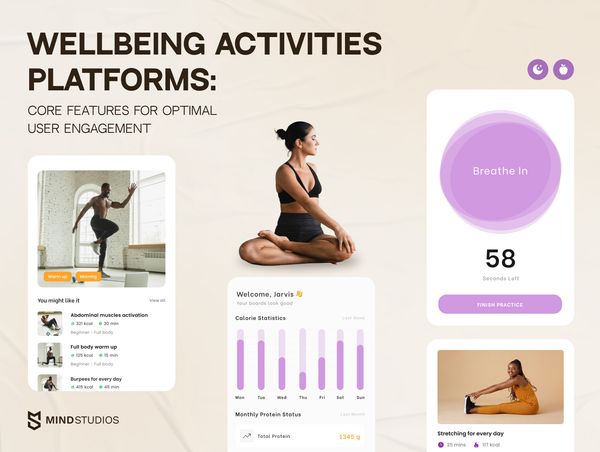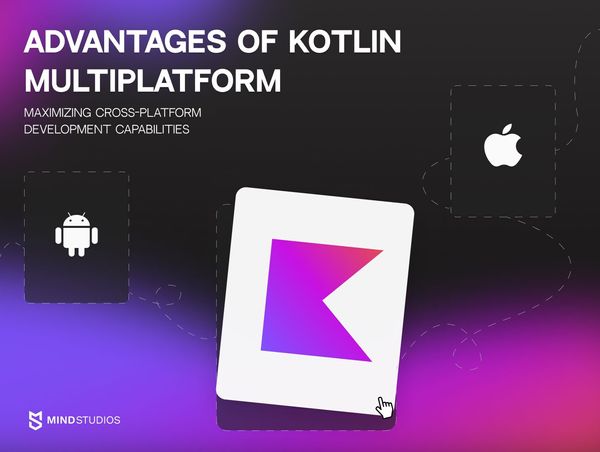
JetBrains, the company behind Kotlin, released a beta version of Kotlin Multiplatform (KMP) in 2022, allowing developers to create applications for various platforms while retaining the perks of native programming. In October 2023, the stable version of the tool was presented, expanding the list of Kotlin Multiplatform advantages. Now, the solution offers a stable API, simplified project configuration, and better interoperability with Objective-C and Swift.
With the diversity of devices and platforms expanding, cross-platform development with solutions like one by Kotlin can become a strategic advantage for tech teams. So, now that the kit is stable and reliable, we decided to dive into the benefits of using Kotlin Multiplatform for software developers and business leaders looking to optimize their tech products.
In this article, we employ our experience in software development to explore how KMP facilitates code sharing, improves performance, and helps cut costs. We also examine the challenges of adopting Kotlin Multiplatform and strategies for overcoming them. If you’re interested in trying out new efficient approaches to software development — keep reading.
Overview of Kotlin Multiplatform
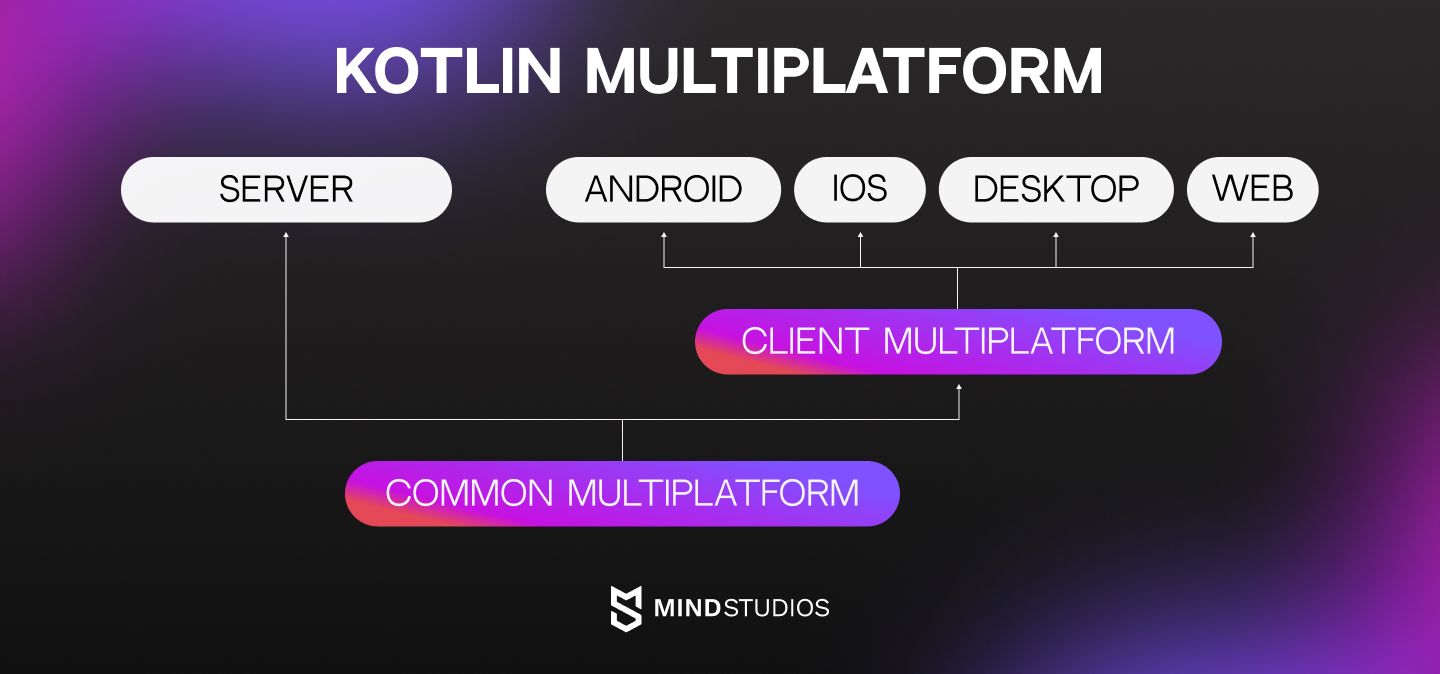
First things first, we need to determine what Kotlin Multiplatform is. This technology is an extension of Kotlin, an open-source programming language initially based on the Java Virtual Machine (JVM). Widely used among Android developers, Kotlin has evolved to support other platforms, particularly through Kotlin Multiplatform, also known as KMP.
Kotlin Multiplatform is a software development kit (SDK) that enables code written in Kotlin to be compiled for various environments and languages, including JVM (+Android), Web (via JavaScript or WebAssembly), and Native (iOS through Objective-C and Desktop using C++). Basically, it allows developers to write common code once and use it across different platforms, thus saving their time and effort. The shared code can include business logic, data models, and utility functions, making it easier to maintain consistency across different parts of an application.
One of the key benefits of Kotlin Multiplatform is its ability to leverage platform-specific features and optimizations while still enabling code sharing. This means that developers can write efficient, high-performance code tailored to the unique characteristics of each platform, ensuring that their applications run smoothly and effectively on any device. Additionally, Kotlin Multiplatform is supported by an active community of developers, providing valuable resources, support, and shared knowledge to help developers make the most of this SDK.
For a while, Kotlin Multiplatform focused on code-sharing between iOS and Android as the most common use case, which led to the introduction of “Kotlin Multiplatform Mobile” (KMM). However, this raised confusion regarding terminology and abbreviations, prompting JetBrains to get rid of the “Kotlin Multiplatform Mobile” name and emphasize “Kotlin Multiplatform” for all code-sharing discussions. KMP facilitates code-sharing across various platforms, including desktop and server-side, with ongoing development efforts enhancing its capabilities. JetBrains encourages content creators and library authors to adopt the unified term “Kotlin Multiplatform” (KMP).
In October 2023, JetBrains announced that Kotlin Multiplatform had shifted from beta to a stable production-ready version, prompting many tech companies to explore this Kotlin cross-platform development tool to optimize their operations and resources. So, what makes this SDK valuable? Let’s find out.
Benefits of adopting Kotlin Multiplatform
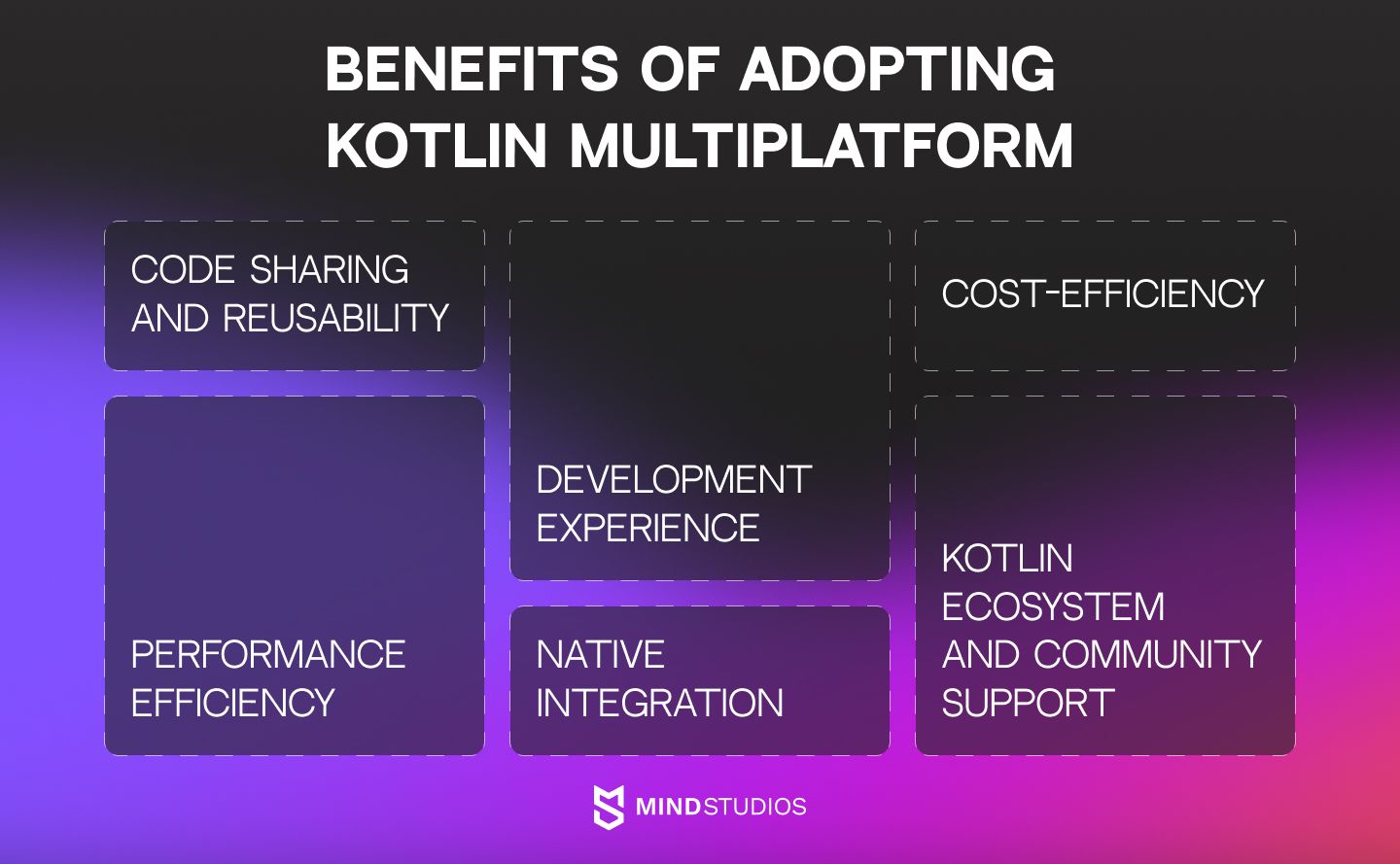
Adopting Kotlin Multiplatform offers multiple benefits not just for developers using it but also for businesses. KMP helps allocate resources more effectively, streamline the development process, and reach multiple platforms with a single codebase, reducing time-to-market and facilitating faster iteration cycles. Furthermore, Kotlin Multiplatform empowers businesses to future-proof their applications, ensuring compatibility with emerging platforms and technologies.
Below, we list the benefits of using Kotlin Multiplatform from both the development and business perspectives.
Code sharing and reusability
One of the primary advantages offered by Kotlin Multiplatform is its ability to streamline code sharing and reusability across different platforms, including Android and iOS. By employing a single codebase, developers can eliminate the need to duplicate code or maintain separate codebases for each platform.
Let’s say you need to develop a messaging application for both Android and iOS platforms. With Kotlin Multiplatform, your development team can write the core logic for sending and receiving messages once in a shared Kotlin codebase. This eliminates the need to duplicate code for handling messaging functionality across platforms. For instance, the data models, networking components, and business logic for message encryption can all be implemented in Kotlin Multiplatform.
Performance efficiency
Another major benefit of Kotlin Multiplatform is that it offers native performance. With KMP, applications get the speed and responsiveness of native apps developed using Java or Objective-C. This translates to a seamless user experience where interactions are smooth and instantaneous.
The secret lies in Kotlin Multiplatform's ability to compile code directly into native binaries for each platform it targets. Unlike some cross-platform frameworks that rely on virtual machines or interpreted code, KMP bypasses such layers, minimizing performance overhead and ensuring that your apps perform optimally across Android and iOS devices.
Native integration
Native integration with Kotlin Multiplatform offers developers seamless access to platform-specific APIs and features. By bridging the gap between platform-specific functionality and shared codebases, the SDK allows tech teams to leverage the full capabilities of each platform while maintaining code consistency and reusability. This means that developers can directly interface with Android and iOS APIs, accessing device sensors, platform-specific UI components, and other native features. For instance, Kotlin Multiplatform offers seamless integration with the Camera API when developing an Android app requiring camera functionality. Likewise, for iOS apps utilizing the accelerometer, KMP provides easy access to the Accelerometer API.
Native integration with Kotlin Multiplatform also enables developers to seamlessly incorporate platform-specific design patterns and conventions into their codebase. This ensures that applications function optimally and adhere to platform-specific guidelines, resulting in a more cohesive user experience. For instance, developers can utilize Android's Material Design components or iOS's UIKit elements directly within their Kotlin Multiplatform code, ensuring the app's UI and interactions feel native to each platform.
Development experience
From the developer’s perspective, Kotlin Multiplatform offers significant advantages in terms of code sharing and productivity. As we’ve already established, by leveraging KMP, tech teams can streamline their workflow and increase productivity by eliminating the need for code duplication. With KMP support for sharing code, it becomes easier for developers to avoid common errors that arise from duplicating codebases, ultimately leading to more reliable and maintainable software solutions.
Those invested in cross-platform mobile development might wonder why choosing Kotlin Multiplatform over other, more mature frameworks makes sense. Despite the merits of technologies like Flutter, React Native, and Xamarin, developers work with Kotlin Multiplatform due to the collaborative efforts of Google and JetBrains teams, particularly for its integration with Native Android. While KMP is still evolving, its flexibility in code sharing across platforms, ranging from shared business logic to unified codebases with Compose Multiplatform, presents a compelling proposition. Moreover, being rooted in Kotlin facilitates smoother migration for native Android developers, offering a significant advantage over other options.
Kotlin ecosystem and community support
One of the core Kotlin advantages is its large community of developers, which is quite active on social media and forums. For tech teams, it means readily available support, resources, and opportunities for collaboration, facilitating faster problem-solving and knowledge sharing.
While the KMP community itself is still not as large as we wish it would be, the surrounding ecosystem indicates that it will continue growing, providing support along with a range of tools, libraries, and frameworks, both official and community-driven. Considering the dynamics, the number of resources for simplifying code sharing and enhancing productivity will likely continue to increase.
Сost-efficiency
As you may have already concluded, Kotlin Multiplatform can significantly enhance cost efficiency by streamlining development processes and reducing resource overhead. When development teams utilize a single codebase for multiple platforms, they can minimize the time and effort spent on managing and synchronizing separate codebases for Android and iOS. As a result, this accelerates the initial development phase and reduces ongoing maintenance costs.
Challenges and mitigation strategies
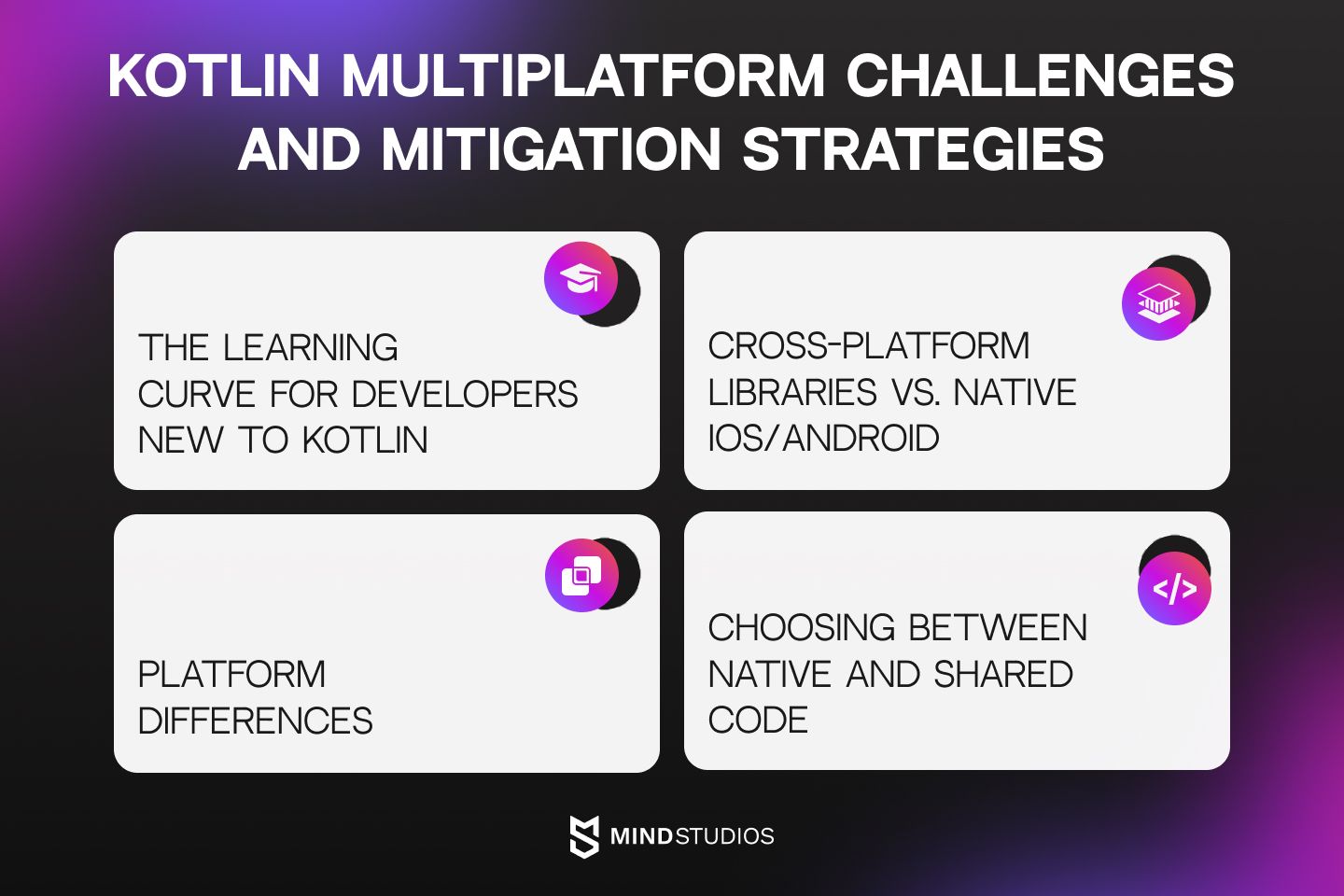
While Kotlin Multiplatform offers numerous benefits, there are also several challenges associated with its adoption (after all, it only became stable in 2023). In this section, we gathered the most common challenges and explored ways to overcome them.
The learning curve for developers new to Kotlin
Diving into cross-platform app development with KMP can feel like stepping into uncharted territory, especially for those new to Kotlin software development. This learning curve can initially slow the development pace as the specialists grapple with understanding Kotlin's syntax, language features, and best practices.
To tackle this challenge head-on, investing in comprehensive training and resources tailored to Kotlin Multiplatform is crucial. This includes accessible and engaging workshops, tutorials, and documentation specifically designed to ease developers into the world of Kotlin. Additionally, it’s crucial to foster a culture of collaboration: by pairing up with colleagues or seeking mentorship from Kotlin experts within the organization, developers can overcome the challenges.
Cross-platform libraries vs. Native iOS/Android
While Kotlin Multiplatform offers the advantage of code sharing, the ecosystem of cross-platform libraries is less mature and comprehensive (for now) compared to native libraries available for iOS and Android development. As a result, developers are left to deal with challenges in terms of functionality, development effort, platform fragmentation, vendor lock-in, and quality assurance.
The mitigation strategy here involves prioritizing research and evaluating existing cross-platform libraries compatible with Kotlin Multiplatform. You can invest in contributing to and improving existing libraries or developing custom solutions where necessary. It also may be helpful to turn to community forums and user groups for support and advice on cross-platform libraries.
Platform differences
Despite the goal of code sharing, differences between platforms, such as UI design patterns, platform-specific APIs, and performance optimizations, may still need to be addressed when developing with Kotlin Multiplatform.
To deal with this issue, you can conduct thorough platform analysis and planning to identify and mitigate platform differences early in the development process. We also recommend utilizing platform-specific modules or extensions to handle platform-specific functionality when necessary. Last but not least, be sure to establish clear guidelines and best practices for managing platform differences and ensure collaboration among developers working on different platforms.
Choosing between native and shared code
Determining when to use native code versus shared code in Kotlin Multiplatform projects can be confusing. The tech team needs to balance factors like platform-specific requirements, code maintainability, performance considerations, and the maturity of cross-platform libraries. While shared code offers the advantage of code reuse and consistency across platforms, it may not always fully leverage platform-specific features or provide optimal performance. On the other hand, native code allows developers to take full advantage of platform capabilities but can result in duplicated efforts and increased complexity.
So, how can you find the right balance between native and shared code? Firstly, it’s crucial to establish clear criteria and guidelines for determining when to use native code or shared code based on factors such as performance requirements, platform-specific functionality, and code complexity. Secondly, you need to conduct regular code reviews and architectural discussions to ensure alignment with established guidelines and best practices. Additionally, we suggest regularly reassessing and refining decision-making processes based on project feedback and evolving requirements.
Use cases and success stories
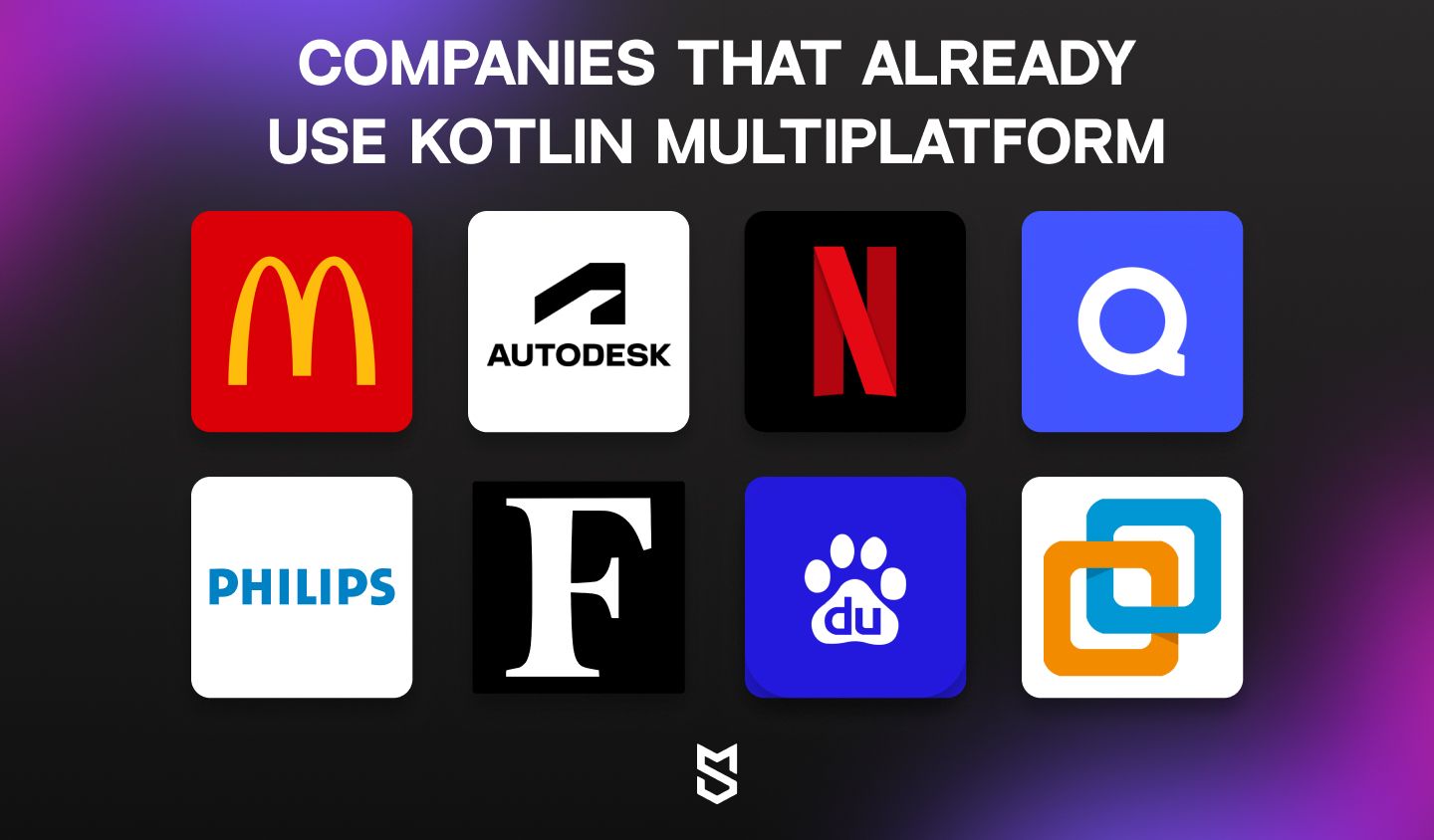
Despite being one of the youngest cross-platform development tools, Kotlin Multiplatform managed to attract some globally known companies. Among their users are tech teams at McDonald’s, Netflix, Philips, VMware, Quizlet, Baidu, and Autodesk.
In fact, Netflix adopted the technology back in 2020. Their app, Prodicle, supports the physical production of TV shows and movies, addressing diverse production team needs with multiple configurations managed internally through Hendrix. Due to common connectivity issues among users, calculations must be performed on the device rather than the backend. Kotlin Multiplatform was chosen to meet these requirements and prevent duplication. On their tech blog, Netflix representatives stated the following:
“Kotlin Multiplatform approaches cross-platform mobile development differently from some well known technologies in the space. Where other technologies abstract away or completely replace platform specific app development, Kotlin Multiplatform is complementary to existing platform specific technologies and is geared towards replacing platform-agnostic business logic. It’s a new tool in the toolbox as opposed to replacing the toolbox.”
In 2023, one more major company switched to KMP: Forbes magazine announced they shifted their mobile app to Kotlin Multiplatform. With over 80% of business logic shared across iOS and Android, new features have been rolled out simultaneously with minimal engineering effort. Rapid internal releases enabled quick feedback iteration, leading to a lean, efficient team, and the app's launch on iOS in September 2023 was marked by features like popular news feeds and seamless access to Forbes' archives.
The rapid follow-up version, driven by user feedback, underscored the agility of KMP. Leveraging Kotlin's community support, the app harnesses various open-source libraries for diverse needs like async processing and data serialization, allowing a focus on core business capabilities rather than infrastructure. This tech move by Forbes sets a compelling precedent for publishers looking to amplify their mobile presence, streamline development, and deliver unified, feature-rich experiences across platforms.
Here are the business advantages of Kotlin Multiplatform highlighted by Forbes:
- Shared business logic: Core capabilities written once are reusable, preventing costly duplication across platforms.
- Faster feature delivery: Over 80% shared logic enables simultaneous feature rollouts, with flexibility for platform-specific customization, fostering innovation and market responsiveness.
- Lower development costs: A single codebase significantly reduces engineering time and effort, resulting in lower overall development costs.
- Open-source plugins: Access to rich open-source plugins allows a focus on core app functionality, boosting efficiency.
- Enhanced user experience: Unified codebase and faster delivery improve the user experience, ensuring Forbes remains at the forefront of technology.
As Kotlin Multiplatform gets more mature, with its community growing, there will likely be many more successful cases of multiplatform app development with this SDK.
Conclusion
The adoption of Kotlin Multiplatform continues to gain momentum, with numerous global companies and startups already leveraging its capabilities to develop cross-platform applications that offer a native-like user experience. While the cross-platform approach is not without its challenges, the development community is enthusiastic about the potential of Kotlin Multiplatform SDK to address these hurdles and streamline the process of building high-quality cross-platform applications.
As experts in mobile development, including Kotlin application development, we at Mind Studios eagerly anticipate the continued growth and impact of Kotlin Multiplatform, paving the way for more efficient and scalable multiplatform development in the future.
If you are unsure which approach best suits your mobile app project, we're here to help. Reach out for a free consultation, and together, we'll explore your idea and determine the optimal implementation strategy.




